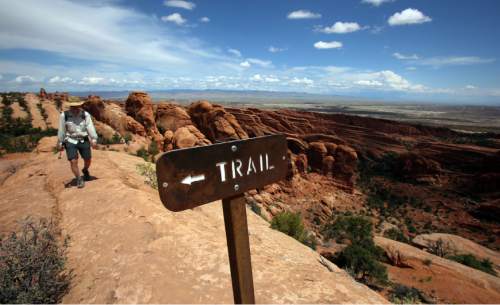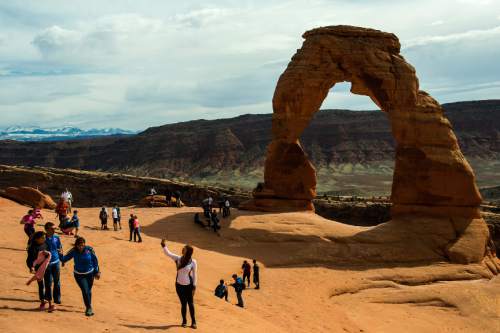This is an archived article that was published on sltrib.com in 2016, and information in the article may be outdated. It is provided only for personal research purposes and may not be reprinted.
Those of us that have spent time in the national parks did a collective forehead slap when we read about the tourists at Yellowstone National Park who recently put a bison calf in their sports-utility vehicle.
It didn't work out for the tourists, who were fined $110, according to the Associated Press. It didn't work out for the calf. Since it was separated from its herd, it was euthanized rather than have it cause "a dangerous situation."
The National Park Service used the episode as a chance to remind visitors not to touch wildlife. That's sound policy, but it's not the only mistake visitors should avoid in the parks.
• Don't feed the wildlife, either. My family and I were in a picnic area at Yellowstone National Park last year when I saw another visitor throwing bread crumbs at a nearby raven. That may seem harmless, but remember: The National Park Service is trying to preserve ecosystems, and they are delicate. Providing foreign food to a species impacts other species. It also keeps the animals you are feeding coming back for more food. Those animals can become aggressive.
• Don't make too much noise. Feel free to talk in your indoor voice as you discuss the beauty you are seeing or you explain to the kids how that arch or mountain was formed. But please don't yell. Don't honk your horn, let your car alarm sound or rev your engine. Please silence your cell phone. There can be lots of great sounds in the national parks, from birds singing to elks and moose calling to the sound of rushing water. Plus, while the national parks aren't libraries, they are supposed to be a place for us to find serenity. It's tough to find that peace when the guy up the trail from you yells back to his buddies, "Brody, bring the cooler!"
• Don't get lost or hurt. Last year, The Salt Lake Tribune published a package of stories about searches and rescues in the national parks. In short, if you need a rescue, it will ruin your trip, maybe put rangers in danger and cost the National Park Service money. It may inconvenience other visitors, too, if rangers have to close a trail to carry you off a mountain or clear a parking lot so a medical helicopter can land. The most common group needing rescue are hikers, men ages 20 to 29. Here's some tips on how to avoid getting hurt or lost.
• Don't vandalize or carve your name in anything. Of everything on this list, this is the one I can't believe I have to write. You can be fined. Just because ancient inhabitants may have scribbled something on a rock doesn't mean it's OK for you to do so. You and your civilization have already created lots of artifacts by which scientists can study you one day. Nor have I ever heard anyone say, "We had such a great time at Zion National Park. You won't believe what we found — a tree in which someone carved 'CLASS OF 1996 RULES!'"
• Don't take anything out of the parks. Do not pick flowers. Other people would like to see them blooming, too. Do not pick up fossils, petrified wood, arrowheads or even rocks. They can help the scientists and historians better learn the park's history. Collecting any of this stuff may also be a crime. If you didn't buy it in the gift shop, don't move it.
• Don't park or stop or walk where you're not supposed to. Traffic is a perpetual problem in some parks and becoming an acute problem in others, including Arches National Park. This can lead to people creating their own parking spots, which is bad. Again, you're in an ecosystem. Please don't tear it up. A lot of park roads don't have shoulders, so pulling over harms the soil, which can lead to erosion, and create traffic hazards. So if you see some wildlife you want to photograph, wait until you get to a designated pull-out or wildlife viewing station. Also, walk only on the pavement, trail or the other designated areas. The southwestern parks have cryptobiotic soil. Even parks that don't do not want new paths carved that will lead to erosion or poor aesthetics.
• Don't buy lunch in the park. Some concessionaires may not like this tip, but from the lines I've seen at the restaurants and stores in the parks, the concessionaires will be fine without you. Trying to buy your own hamburger will only add to the congestion in places that are already congested. Besides, instead of waiting in line at a food stand, you could be eating a sack lunch in front of some beautiful park vista. Just don't give the ravens a bite of your sandwich.
What did I forget? Send a tweet to @UtahHikes or post on our Facebook page.





